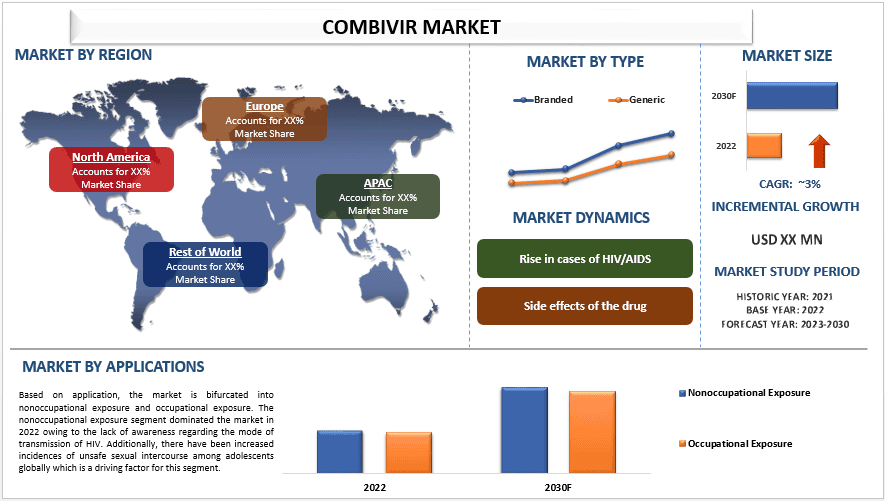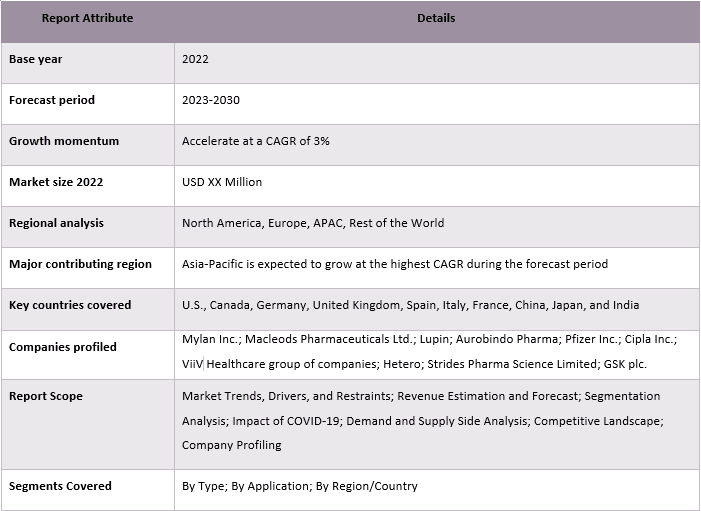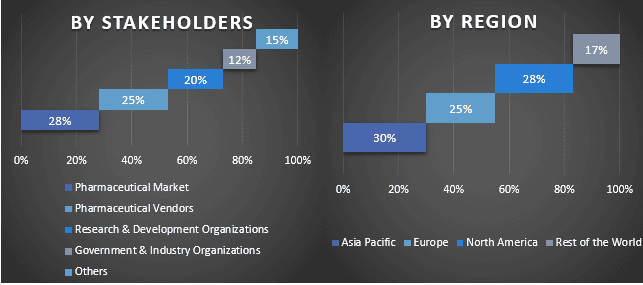コンビビル市場:現在の分析と予測(2023年~2030年)
タイプ(ブランド品および一般品)の強調; アプリケーション(非職業的曝露および職業的曝露); および地域/国

世界のコンビビル市場は、予測期間中に約3%の著しい成長率で成長すると予想されています。コンビビルは、ラミブジンとジドブジンの組み合わせで作られた薬剤で、ヒト免疫不全ウイルスに対する抗レトロウイルス薬として使用されています。コンビビルは主に、世界的にAIDS(後天性免疫不全症候群)の症例が増加したために注目を集めました。例えば、米国の国立公衆衛生機関である疾病管理予防センターの報告によると、米国では2021年末時点で推定120万人がHIVに感染していました。これに加えて、医療部門への投資やHIV/AIDSに関する政府の啓発プログラムが近年大幅に増加しており、市場に機会をもたらす重要な要因となっています。例えば、米国は、性感染症の最近の急増を逆転させるための性感染症国家戦略計画を立ち上げました。その目標は、学校や他の専門家、家族において、健康教育を活用し、性感染症を予防し、青年期の人々が健康的な人間関係、安全な性行為、生殖に関する健康について、十分な情報に基づいた、前向きで安全な選択ができるようにすることです。
Mylan Inc.; Macleods Pharmaceuticals Ltd.; Lupin; Aurobindo Pharma; Pfizer Inc.; Cipla Inc.; ViiV Healthcare group of companies; Hetero; Strides Pharma Science Limited; GSK plc. は、市場の主要なプレーヤーの一部です。これらのプレーヤーは、ハイテクで革新的な製品/技術を顧客に提供するために、いくつかのM&Aやパートナーシップを実施しています。
レポートで提示されている洞察
「タイプ別では、ジェネリックカテゴリーが予測期間中により高いCAGRを記録する」
タイプに基づいて、市場はブランドとジェネリックに二分されます。ジェネリックセグメントは、ブランド薬の費用対効果の高い代替品であるため、予測期間中に高いCAGRで成長すると予想されています。それらは最大の地域で簡単に入手でき、中所得から低所得の国の人々にとって手頃な価格です。例えば、2022年には、Accessible Medicinesのための協会が米国ジェネリックおよびバイオシミラー医薬品の貯蓄レポートを発表し、ジェネリックおよびバイオシミラー医薬品が2021年にアメリカの患者と医療システムに過去最高の3730億米ドルを生み出したと報告されました。 したがって、ジェネリックカテゴリーは、予測期間中により高いCAGRを記録すると予想されます。
「アプリケーション別では、非職業的曝露が2022年に市場で大きなシェアを占めた」
アプリケーションに基づいて、市場は非職業的曝露と職業的曝露に二分されます。非職業的曝露セグメントは、HIVの感染経路に関する認識の欠如により、2022年に市場を支配しました。さらに、世界的に青年期の人々の間で安全でない性交の発生が増加しており、これがこのセグメントの推進要因となっています。例えば、米国を拠点とするNational Youth Risk Behavior Survey、2021によると、高校生の30%が性行為に関与しており、そのうち48%が保護されていない性交をしていると報告しました。したがって、非職業的曝露セグメントは、2022年に市場の大きなシェアを占めました。
「地域別では、APAC地域が予測期間中に高いCAGRで成長すると予想される」
コンビビルの市場採用をよりよく理解するために、市場は、北米(米国、カナダ、および北米の残りの地域)、ヨーロッパ(ドイツ、英国、フランス、スペイン、イタリア、ヨーロッパの残りの地域)、アジア太平洋(中国、日本、インド、アジア太平洋の残りの地域)、世界のその他の地域などの国における世界的な存在に基づいて分析されます。APACは、予測期間中に高いCAGRで成長すると予想されます。この地域における成人および青年期の薬物中毒の急増などのいくつかの要因。たとえば、インドの内務省は、2019年から2021年の間に、ウッタルプラデシュ州(31,482件)で薬物中毒の症例が最も多く、次いでマハラシュトラ州(28,959件)、パンジャブ州(28417件)であったと報告しました。さらに、HIV/AIDSの発生率の増加、コンビビルによる幅広い治療法の開発、医薬品へのアクセスの向上、主要なジェネリック医薬品会社の存在、政府のイニシアチブと特別なコミュニティの急増も、市場の成長にプラスの影響を与えています。したがって、APAC地域は、予測期間中により高いCAGRを記録すると予想されます。

このレポートを購入する理由:
- この調査には、認証された主要な業界専門家によって検証された市場規模と予測分析が含まれています。
- レポートは、業界全体のパフォーマンスの簡単なレビューを一目で示します。
- レポートは、主要なビジネス財務、製品ポートフォリオ、拡張戦略、および最近の開発に主な焦点を当てて、著名な業界の同業者の詳細な分析をカバーしています。
- 業界で一般的な推進要因、制約、主要な傾向、および機会の詳細な検討。
- この調査では、さまざまなセグメントにわたる市場を包括的にカバーしています。
- 業界の地域レベルの分析を深く掘り下げます。
カスタマイズオプション:
世界のコンビビル市場は、要件またはその他の市場セグメントに応じてさらにカスタマイズできます。これに加えて、UMIは、お客様独自のビジネスニーズがあることを理解しているため、お客様の要件に完全に適合するレポートを入手するために、お気軽にお問い合わせください。
目次
コンビビル市場分析(2023年~2030年)の調査方法
グローバルコンビビル市場の過去の市場を分析し、現在の市場を推定し、将来の市場を予測することは、世界の主要地域におけるコンビビルの採用を構築し分析するために行われた3つの主要なステップでした。徹底的な二次調査を実施して、過去の市場数値を収集し、現在の市場規模を推定しました。次に、これらの洞察を検証するために、多数の調査結果と仮定が考慮されました。さらに、グローバルコンビビル市場のバリューチェーン全体にわたる業界の専門家との徹底的な主要インタビューも実施されました。主要インタビューを通じて市場数値を仮定および検証した後、トップダウン/ボトムアップアプローチを採用して、完全な市場規模を予測しました。その後、市場の内訳とデータの三角測量法を採用して、業界に該当するセグメントとサブセグメントの市場規模を推定および分析しました。詳細な方法論は以下で説明されています。
過去の市場規模の分析
ステップ1:二次ソースの詳細な調査:
年次報告書と財務諸表、業績プレゼンテーション、プレスリリースなどの企業内部ソース、およびジャーナル、ニュースと記事、政府刊行物、競合他社の刊行物、セクターレポート、サードパーティデータベース、およびその他の信頼できる刊行物などの外部ソースを通じて、コンビビル市場の過去の市場規模を取得するために、詳細な二次調査を実施しました。
ステップ2:市場セグメンテーション:
コンビビル市場の過去の市場規模を取得した後、主要地域のさまざまなセグメントとサブセグメントに関する過去の市場の洞察とシェアを収集するために、詳細な二次分析を実施しました。主要なセグメントは、タイプ、アプリケーション、および地域としてレポートに含まれています。さらに、その地域でのテストモデルの全体的な採用を評価するために、国レベルの分析を実施しました。
ステップ3:要因分析:
さまざまなセグメントとサブセグメントの過去の市場規模を取得した後、コンビビル市場の現在の市場規模を推定するために、詳細な要因分析を実施しました。さらに、コンビビルのタイプ、アプリケーション、および地域などの従属変数と独立変数を使用して、要因分析を実施しました。世界中のコンビビル市場セクターにおけるトップパートナーシップ、合併と買収、事業拡大、および製品の発売を考慮して、需要と供給側のシナリオについて徹底的な分析を実施しました。
現在の市場規模の推定と予測
現在の市場規模の算出:上記の3つのステップからの実用的な洞察に基づいて、現在の市場規模、グローバルコンビビル市場の主要プレーヤー、およびセグメントの市場シェアに到達しました。必要なすべてのパーセンテージシェアの分割と市場の内訳は、上記の二次的なアプローチを使用して決定され、主要インタビューを通じて検証されました。
推定と予測:市場の推定と予測のために、利害関係者が利用できる推進要因と傾向、制約、および機会を含むさまざまな要因に重みが割り当てられました。これらの要因を分析した後、関連する予測手法(つまり、トップダウン/ボトムアップアプローチ)を適用して、世界の主要市場全体でさまざまなセグメントとサブセグメントの2030年の市場予測に到達しました。市場規模を推定するために採用された調査方法論は、次のとおりです。
- 収益(米ドル)の面での業界の市場規模と、国内の主要市場全体でのコンビビル市場の採用率
- 市場セグメントとサブセグメントのすべてのパーセンテージシェア、分割、および内訳
- 提供される製品の面でのグローバルコンビビル市場の主要プレーヤー。また、急速に成長している市場で競争するためにこれらのプレーヤーが採用した成長戦略
市場規模とシェアの検証
一次調査:主要地域全体のトップレベルのエグゼクティブ(CXO / VP、営業部長、マーケティング部長、運用部長、地域部長、カントリー部長など)を含む主要なオピニオンリーダー(KOL)との詳細なインタビューを実施しました。次に、一次調査の結果を要約し、統計分析を実行して、述べられた仮説を証明しました。一次調査からのインプットは二次的な調査結果と統合され、それによって情報が実用的な洞察に変わりました。
さまざまな地域における一次参加者の分割

市場エンジニアリング
データ三角測量技術を採用して、全体的な市場推定を完了し、グローバルコンビビル市場の各セグメントおよびサブセグメントの正確な統計数値を算出しました。グローバルコンビビル市場におけるタイプ、アプリケーション、および地域の分野におけるさまざまなパラメーターとトレンドを調査した後、データをいくつかのセグメントとサブセグメントに分割しました。
グローバルコンビビル市場調査の主な目的
グローバルコンビビル市場の現在および将来の市場動向は、調査で特定されました。投資家は、調査で実施された定性的および定量的分析に基づいて、投資に関する裁量を基づかせるための戦略的洞察を得ることができます。現在および将来の市場動向は、地域レベルでの市場の全体的な魅力を決定し、産業参加者が未開発市場を利用して、先行者利益から恩恵を受けるためのプラットフォームを提供しました。調査のその他の定量的な目標は次のとおりです。
- 価値(米ドル)の面でコンビビル市場の現在および予測市場規模を分析します。また、さまざまなセグメントとサブセグメントの現在および予測市場規模を分析します
- 調査のセグメントには、タイプ、アプリケーション、および地域の分野が含まれます
- コンビビル業界の規制の枠組みを定義および分析します。
- 業界の顧客と競合他社の行動を分析するとともに、さまざまな仲介業者の存在に関連するバリューチェーンを分析します。
- 主要地域のコンビビル市場の現在および予測市場規模を分析します。
- レポートで調査された地域の主要国には、アジア太平洋、ヨーロッパ、北米、およびその他の地域が含まれます。
- コンビビル市場の企業プロファイルと、急速に成長している市場で持続するために市場プレーヤーが採用した成長戦略
- 業界の地域レベルの分析を深めます
よくある質問 よくある質問
Q1: コンビビル市場の現在の市場規模と成長の可能性は何ですか?
Q2:コンビビルの市場成長を牽引する要因は何ですか?
Q3:タイプ別に見ると、コンビビルの市場で最大のシェアを占めているセグメントはどれですか?
Q4: コンビビル市場における新たなテクノロジーとトレンドは何ですか?
Q5:コンビビル市場を支配するのはどの地域ですか?
Q6:コンビビル市場で活動している主要企業はどこですか?
関連 レポート
この商品を購入したお客様はこれも購入しました










